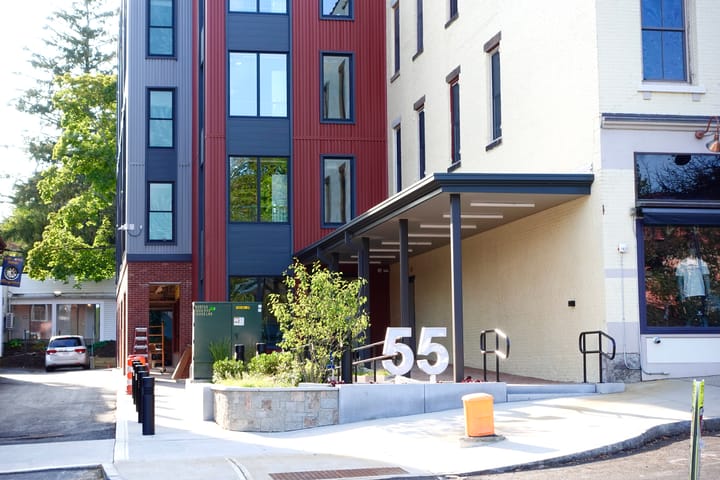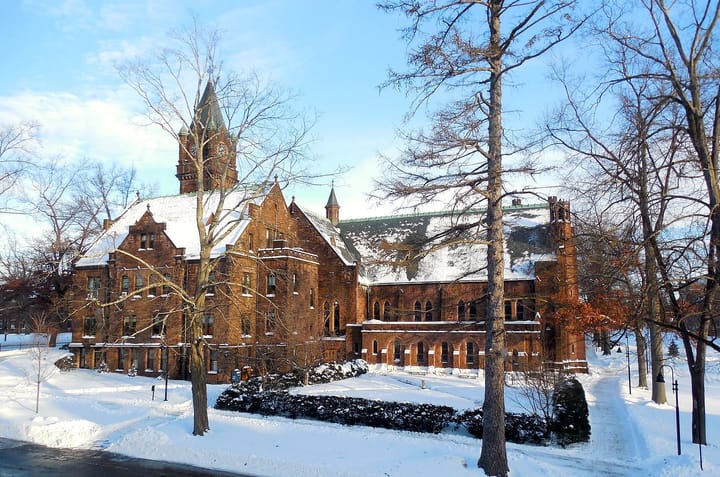Palatable Queerness
As their sophomore year begins, Assistant Opinion Editor Caroline Flinn ’28 reflects on the tension between belonging and queerness as they grapple with the fear of becoming too “palatable” to heteronormativity rather than being politically urgent.
When I arrived on campus last fall, I was lucky. Within the first few days of orientation, I met the people who would become my closest friends. I know this is a privilege; many first-years spend months navigating awkward dining hall encounters, half-hearted group chats, and the loneliness of weekends without plans. It is rare to feel rooted in a new place so quickly, and I remain grateful for the community that I found almost immediately. The college made this transition possible by surrounding me with the visibility of queer life on campus, which allowed me to step more fully and openly into a queer identity I had not been able to claim back home, and still cannot fit into whenever I return.
Yet even within this comfort, a tension persists. Most of the people who became my chosen family during those early weeks were not queer. They are endlessly supportive, deeply affirming, and have never once made me feel unwelcome in my identity. But the absence of shared queerness lingers. Having called myself queer for only about a year, I feel a deep desire for queer community, for the guidance and solidarity that comes with it.
This distance leaves me with an undercurrent of unease: What does it mean that my most intimate relationships are with people who cannot share the embodied experience of queerness? What does it mean that my daily expressions of queerness — my jokes, my stories, my fears — take place in a context where it is legible to others as difference, never as sameness?
That unease is more than personal; it is political. Queerness is not only about who we love or how we identify — it is also a political stance, a refusal to conform to the heteronormative structures that shape the world around us. Queer and trans rights are currently precarious, with anti-LGBTQ+ legislation being routinely proposed and passed, and trans existence being attacked in statehouses and on television. In this context, the act of living “queerly” is inseparable from its political stakes.
I worry that the version of myself I embody within my friend group is one that is comfortable for them, but not what I truly want it to be. I find myself smoothing out the sharper edges of my queer identity — like the night a classmate casually asked if I’d ever ‘get with a guy,’ and instead of correcting them or expressing how frustrating it felt, I laughed along and changed the subject — muting the anger or sadness that comes with being queer in a country where my rights can be debated away in a legislative session.
I know that Amherst has a large queer community, all bolstered by student organizations, parties, and the Queer Resource Center. I’ve met queer classmates who inspire me, whose very presence feels like resistance to the pressure of assimilation. And yet, I’ve held that community at arm’s length. Part of this is circumstantial: the convenience of my early friend group, the inertia of staying where I feel secure. But part of it is fear — fear of not being “queer enough,” fear of being judged for the ways my social life is entangled with heteronormativity, fear of exposing the gap between the identity I claim and the life I lead.
I often think about something Yale professor Greta LaFleur has suggested: that simply being a lesbian does not necessarily mean one is living queerly, since lesbian identity itself can still fall into heteronormative patterns of domesticity and respectability. That idea haunts me, because it sharpens my own fear: I don’t ever want to fall into that. I don’t want my queerness to be so assimilated, so palatable, that it loses its political edge entirely.
This tension leaves me with a nagging question: Am I living queerness authentically, or am I enacting a form of queerness that fits too neatly within heteronormative structures — like when I described a date with a girl to my family as ‘just a friend’ to avoid questions, even though it felt deeply intimate to me? I had hidden my queerness from my high school friends for years, and didn’t come out to my mom — or tell her about my relationship — until after the relationship had ended, a pattern of silencing myself that makes me wonder how much of my identity is truly mine to show, and how much is shaped to fit the comfort of others.
The discourse around palatable queerness is not confined to campus life. It reverberates across contemporary media and consumer culture. Every June, rainbow logos proliferate across storefronts and advertisements, rendering queerness into a marketable aesthetic. This phenomenon — called rainbow capitalism — is not a genuine engagement with queer struggle but rather a commodification of identity, reducing queerness to symbols that can be purchased, displayed, and discarded when no longer profitable as in July.
A similar tension has played out in pop culture in recent months, particularly on queer TikTok, with debates surrounding artists like JoJo Siwa, Fletcher, and Betty Who. These artists built careers with the support of queer audiences, offering representation in an industry where queer women are still markedly underrepresented. When Siwa and Fletcher both recently announced relationships with men, the response on TikTok and in queer online spaces was swift and polarized. Some accused them of queerbaiting, others of biphobia, but beneath the noise was a more profound anxiety: that queerness is being wielded as a tool to build audience loyalty that is then strategically abandoned when it complicates mainstream palatability.
Betty Who’s recent podcast comments intensified this unease. Although she described herself as bisexual and empathetic to the pressures of public identity, her suggestion that an out lesbian like Reneé Rapp might one day ‘fall in love with a man’ drew on the very tropes queer communities have long resisted, framing lesbianism as a provisional identity, merely waiting for heterosexual ‘correction.’ The backlash reflected a collective frustration with the way queerness can be flattened into a kind of consumer product — an identity brand to be marketed for visibility and then diluted to preserve mainstream acceptability.
What unsettles me most is how familiar this feels. The drama unfolding on queer TikTok is not just about celebrities but about the broader risk of assimilation: that queerness, once a refusal of normativity, can be softened, packaged, and resold until it ceases to challenge anything at all. Watching these conversations online, I recognize my own fear reflected back — the fear that queerness, whether in music, advertising, or even my own social life, might become palatable instead of politically urgent.
All of this makes me return again and again to a larger, unsettling question about the purpose of queerness. When it exists only in forms that are profitable, comfortable, or easy to consume, it risks losing its radical edge. Queerness has always been, at its heart, a challenge to dominant norms: a refusal of heteronormativity, an insistence on alternative ways of living and loving, an embrace of possibility that unsettles rather than appeases.
At the same time, I resist framing queerness as a kind of purity test, where authenticity is measured by proximity to suffering or by the degree to which one resists heterosexual spaces. That logic replicates the very gatekeeping and exclusion that queerness, at its best, attempts to undo. To be queer is not to achieve some static state of radical resistance; it is to remain in motion, to embrace the messiness of desire and identity, to seek connections that cannot always be neatly categorized. Queerness is not an answer but a method: a way of questioning, resisting, and reimagining.
Looking back on my freshman year, I see clearly how belonging and queerness are not the same thing. Belonging is what I was lucky enough to find immediately. But a queer home is something different, something I am still learning to build: a space where I do not simply fit into existing structures but participate in reshaping them. Sophomore year, then, feels like an invitation to move past the safety of palatability, to lean into the aspects of queerness that make others uncomfortable, and to resist the temptation to sand down my edges for the sake of acceptance. It is a year to commit to queerness not just as my identity but as my politics — as a refusal of assimilation, a practice of solidarity, and a search for new ways of belonging that are fully, unapologetically my own.





Comments ()